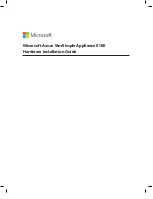
Seagate Enterprise Performance - 3.5 HDD SAS Product Manual, Rev. B
35
8.5
Deferred Auto-Reallocation
Deferred Auto-Reallocation (DAR) simplifies reallocation algorithms at the system level by allowing the drive to reallocate unreadable locations on a
subsequent write command. Sites are marked for DAR during read operations performed by the drive. When a write command is received for an
LBA marked for DAR, the auto-reallocation process is invoked and attempts to rewrite the data to the original location. If a verification of this rewrite
fails, the sector is re-mapped to a spare location.
This is in contrast to the system having to use the Reassign Command to reassign a location that was unreadable and then generate a write
command to rewrite the data. DAR is most effective when AWRE and ARRE are enabled—this is the default setting from the Seagate factory. With
AWRE and ARRE disabled DAR is unable to reallocate the failing location and will report an error sense code indicating that a write command is
being attempted to a previously failing location.
8.6
Protection Information (PI)
Protection Information is intended as a standardized approach to system level LRC traditionally provided by systems using 4104 byte formatted
LBAs. Drives formatted with PI information provide the same, common LBA count (i.e. same capacity point) as non-PI formatted drives. Sequential
performance of a PI drive will be reduced by approximately 1.56% due to the extra overhead of PI being transferred from the media that is not
calculated as part of the data transferred to the host. To determine the full transfer rate of a PI drive, transfers should be calculated by adding the 8
extra bytes of PI to the transferred LBA length, i.e. 4096 + 8 = 4104. PI formatted drives are physically formatted to 4104 byte sectors that store 4096
bytes of customer data with 8 bytes of Protection Information appended to it. The advantage of PI is that the Protection Information bits can be
managed at the HBA and HBA driver level. Allowing a system that typically does not support 4104 LBA formats to integrate this level of protection.
Protection Information is valid with any supported LBA size. 4096 LBA size is used here as common example.
8.6.1
Levels of PI
There are 4 types of Protection Information.
Type 0
- Describes a drive that is not formatted with PI information bytes. This allows for legacy support in non-PI systems.
Type 1
- Provides support of PI protection using 10 and 16 byte commands. The RDPROTECT and WRTPROTECT bits allow for checking control
through the CDB. Eight bytes of Protection Information are transmitted at LBA boundaries across the interface if RDPROTECT and WRTPROTECT bits
are nonzero values. Type 1 does not allow the use of 32 byte commands.
Type 2
- Provides checking control and additional expected fields within the 32 byte CDBs. Eight bytes of Protection Information are transmitted at
LBA boundaries across the interface if RDPROTECT and WRTPROTECT bits are nonzero values. Type 2 does allow the use of 10 and 16 byte
commands with zero values in the RDPROTECT and WRTPROTECT fields. The drive will generate 8 bytes (e.g.0xFFFF) 8 bytes of Protection
Information to be stored on the media, but the 8 bytes will not be transferred to the host during a read command.
Type 3
- Seagate products do not support Type 3.
8.6.2
Setting and determining the current Type Level
A drive is initialized to a type of PI by using the format command on a PI capable drive. Once a drive is formatted to a PI Type, it may be queried by a
Read Capacity (16) command to report the PI type which it is currently formatted to. PI Types cannot coexist on a single drive. A drive can only be
formatted to a single PI Type. It can be changed at anytime to a new Type but requires a low level format which destroys all existing data on the
drive. No other vehicle for changing the PI type is provided by the T10 SBC3 specification.
Type 1 PI format CDB command: 04 90 00 00 00 00, Write Buffer: 00 A0 00 00
Type 2 PI format CDB command: 04 D0 00 00 00 00, Write Buffer: 00 A0 00 00
8.6.3
Identifying a Protection Information drive
The Standard Inquiry provides a bit to indicate if PI is support by the drive. Vital Product Descriptor (VPD) page 0x86 provides bits to indicate the PI
Types supported and which PI fields the drive supports checking.
Note
For further details with respect to PI, please refer to SCSI
Block Commands - 3 (SBC-3) Draft Standard documentation.
















































